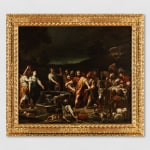-
Biography
Giuseppe Maria Crespi, known as Lo Spagnuolo (Bologna, Italy, 1665 - Bologna, Italy, 1747)
Born in Bologna in 1665 and belonging to the Bolognese school, he trained first with Angelo Michele Toni (1640-1708), and later in the Bolognese school of Domenico Maria Canuti (1620-1660), as well as in the Accademia del nudo of Carlo Cignani (1628-1719).
He moved between Venice, Parma and Urbino, where from a very young age he was influenced by Parmigianino, Baroccio and especially Guercino.
He was nicknamed Lo Spagnuolo (The Spaniard) because of the clothing he wore that was influenced by the 'Spanish' fashion of the time.
He also continued to train thanks to his financiers: under Ferdinando de' Medici, he had the opportunity to learn about Flemish and Dutch art in the Medici collections. For him he produced, among many others, the great paintings Fiera di Poggio a Caiano and Strage degli Innocenti (Uffizi).
An eclectic painter, capable of ranging from sacred to portrait painting, particularly influenced by Venetian art, especially in his colours and subjects, Crespi is also known for his portraits and caricatures, as well as his genre engravings, in which he took up Rembrandt's stile.
Between 1712 and 1714, he was the director of painting courses at the Accademia Clementina in Bologna, becoming a point of reference for students in the surrounding area. In recognition of the widespread fame he had earned, on Christmas Day 1740, he received a solemn golden cross and the title of knight conferred on him by Benedict XIV.
Five years later, in 1745, he lost his sight, without which he could no longer paint.
He died in Bologna in 1747.
Photo UniCredit Group (Sebastiano Pellion di Persano)
-
Works
Giuseppe Maria Crespi, known as lo Spagnuolo, and Bottega Italian, 1665-1747
Mosè difende le figlie di JetroSeries:Olio su tela/ Oil on canvas / Öl auf Leinwand52 x 60 5/8 in
132 x 154 cmUniCredit S.p,A.Photo: UniCredit Group (Sebastiano Pellion di Persano)Further images
Join our mailing list
* denotes required fields
In order to respond to your enquiry, we will process the personal data you have supplied in accordance with our privacy policy.














